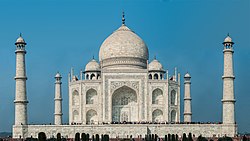Taj Mahal
| Taj Mahal ताजमहल. | |
|---|---|
 Taj Mahal | |
| Location | Agra, Uttar Pradesh, India |
| Coordinates | 27°10′30″N 78°02′31″E / 27.17500°N 78.04194°ECoordinates: 27°10′30″N 78°02′31″E / 27.17500°N 78.04194°E ⧼validator-fatal-error⧽ |
| Height | 73 metres (240 ft) |
| Built | 1632–53[1] |
| Architect | Ustad Ahmad Lahauri |
| Architectural style(s) | Mughal architecture |
| Visitors | 7–8 million[2] (in 2016) |
| Type | Cultural |
| Criteria | (i) |
| Designated | 1983 (7th session) |
| Reference no. | 252 |
| State Party | India |
| Region | Asia-Pacific |
The Taj Mahal is an Islamic religious building, mosque and tomb in India. It was built in the 17th century by Emperor Shah Jahan in memory of his wife, Mumtaz Mahal. Its chief architect was Ustad Ahmad Lahauri.
The building is in the city of Agra, Uttar Pradesh. It is widely thought as one of the most beautiful buildings in the world.[who?] It is one of India's biggest tourist attractions.
The Taj Mahal is listed as a UNESCO World Heritage Site, together with the Agra Fort, 2.5 kilometers away. It was listed as one of the 7 Wonders of the World in 2007. It is on the south bank of the Yamuna river in Agra.
The building was originally white. Because of pollution, it is turning yellow. Sulphur dioxide in the atmosphere reacts with water molecules and becomes sulphuric acid, which slowly destroys the outer layer of the building.
The Taj Mahal is one of the most notable examples of Islamic architecture ever built. When it was built, most of India was ruled over by the Mughal Empire except the South. Shah Jahan was a Mughal emperor who came into power around 1628. According to historians, Shah Jahan loved building and architecture, which gave him the nickname “The Builder Of Marvels”. The Taj Mahal was built for Shah Jahan’s third wife, Mumtaz Mahal- meaning the “Jewel of the palace”. She became ill giving birth to their 14th child. As she was about to die, she asked Shah Jahan to make her the most beautiful tomb that was ever built. She died on 17 June 1631. In 1657, Shah Jahan fell ill. He died in captivity in 1666. His tomb was placed besides Mumtaz Mahal's.
Construction[edit]
The Taj Mahal is an example of Muslim Architecture – a mixture of building design influenced from Middle Eastern, Indian, Turkish, and Ottoman architecture.
The Taj Mahal was built with materials from all over the world. Over 20,000 people were used to move building materials. It is generally thought that Ustad Ahmad Lahauri was in charge of the construction.[3] The building was finished in 1648.[4] The construction of Taj Mahal is about 6000 feet.
Tours[edit]
The Taj Mahal had 2 million visitors in 2001. In 2014-2017 there were more than 7-8 million visitors.
Damage[edit]
Many people think the Taj Mahal is one of the most beautiful buildings ever built. However, it is slowly being damaged by acid rain in the nearby Yamuna Basin.[5] A nearby oil refinery has been blamed for some of the damage. In 1996, the Indian Supreme Court said that local industry was harming the Taj Mahal.[6] The court set up an area of 10,400 square metres around the Taj Mahal called the Taj Trapezium Zone. Industries within this zone must use natural gas instead of coal.[7]
Because of pollution, the Taj Mahal is getting yellower slowly.
References[edit]
| Wikimedia Commons has media related to Taj Mahal. |
- ↑ Dutemple, Lesley A (2003). The Taj Mahal. Lerner Publications Co. p. 32. ISBN 0-8225-4694-9. Retrieved 7 February 2015. Search this book on

- ↑ "Archaeological Survey of India Agra working on compiling visual archives on Taj Mahal". The Economic Times. 29 November 2015. Retrieved 16 January 2016.
- ↑ UNESCO advisory body evaluation.
- ↑ Ganguly, Meenaksy (September 10, 2001). "At The Taj Mahal, Grime Amid Grandeur - TIME". time.com. Archived from the original on January 17, 2012. Retrieved April 2, 2011. Unknown parameter
|url-status=ignored (help) - ↑ "News - Environment: India's famed Taj Mahal is losing its lustre". iol.co.za. Archived from the original on April 27, 2006. Retrieved April 29, 2010. Unknown parameter
|url-status=ignored (help) - ↑ Morley, Ian (April 11, 2007). "ArchitectureWeek - Culture - Saving the Taj Mahal - 2007.0411". architectureweek.com. Archived from the original on March 26, 2011. Retrieved April 2, 2011. Unknown parameter
|url-status=ignored (help) - ↑ "Why is the Taj Trapezium Zone and why is it called so?". Times of India. May 4, 2008. Archived from the original on March 1, 2012. Retrieved April 2, 2011. Unknown parameter
|url-status=ignored (help)

